Playing With Fire – Teri Martens
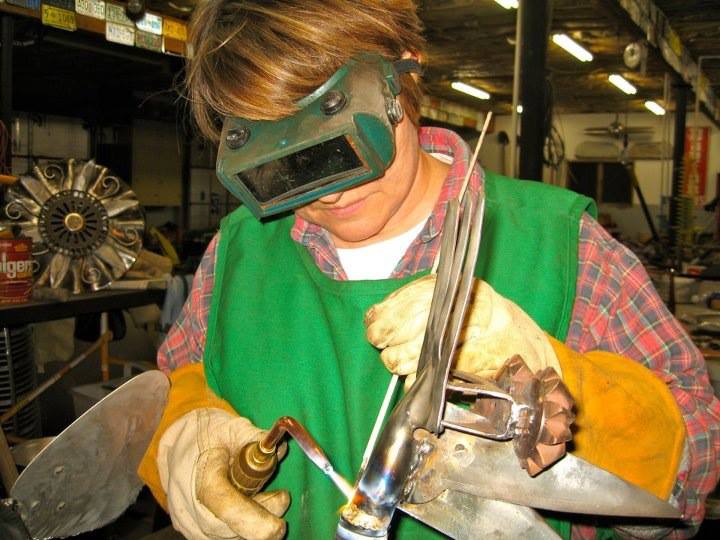
It’s a bright blue April day, when the air is full of birdsong and the sun shines with golden promise. A pair of cardinals sing and repeat, like a married couple, hopping from branch to branch, the leaves beginning to unfurl in the slight spring breeze. Through the open garage doors on the big yellow barn there’s a
“Teri’s first weld was better than most of the other students’ last weld.”
grinding sound, then the ping of a hammer on an anvil. Inside no one is paying attention to the nice day, the glorious sunshine or the emerging spring flowers. The girl working inside has a single purpose today: Create a set of hooves from scrap pipe and weld them onto the legs of a metal horse, so the horse appears to be cantering naturally. Sounds easy enough. It is not.
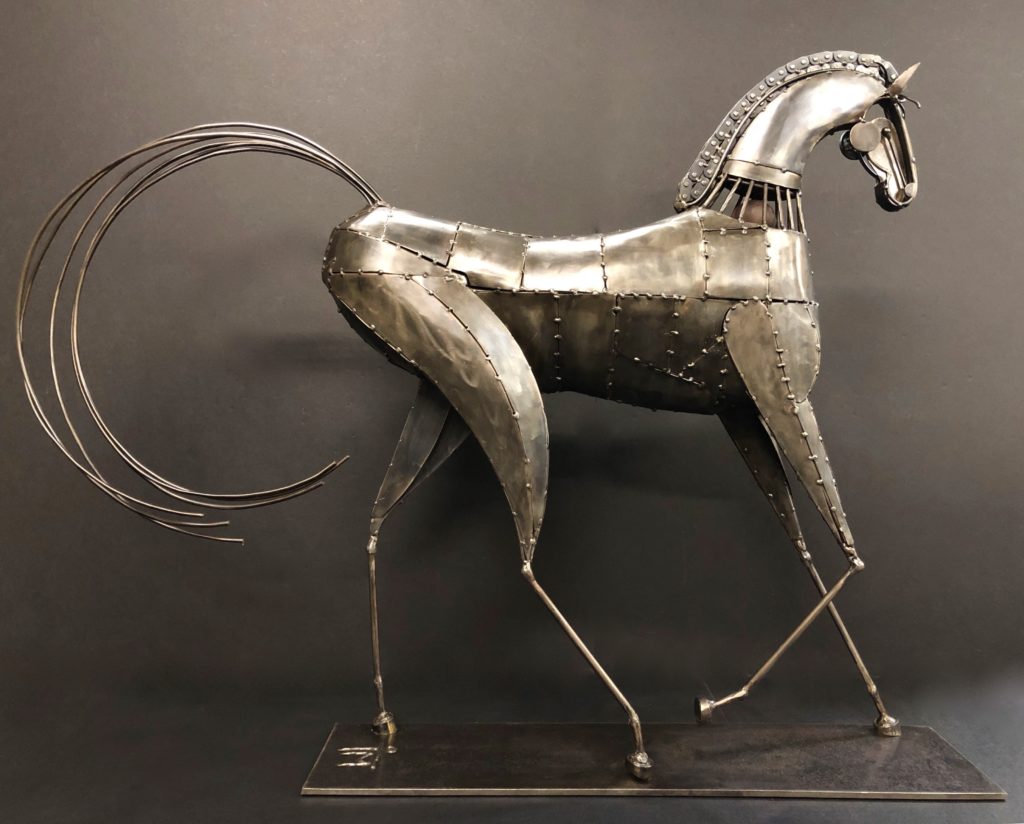
The horse sculpture is suspended from an L-shaped bar mounted to the edge of the welding table. Magnets, so strong they must be hit with a hammer to be removed, are holding everything together. The whole thing is still wobbly at best, but the horse’s legs must be suspended just above the mounting plate so three of the hooves can be attached and welded from below. The fourth hoof, the right front, will be positioned extended backwards under the belly and will not attach to the plate. The gait must be exact with an ever-so-slight tilt to the left as the horse strides forward. The girl is not confident that she’ll get it right the first time. Usually she doesn’t. She is patient, however, and the hope is that as the hooves are welded to the plate they will not pull right or left throwing everything else off and, that the electrical ground is solid so there is minimal spatter. In the seconds leading up to the weld it comes down to intuition; the angle of the hoof to the leg, when to pull the stinger trigger, how long to hold the trigger, the sound the stinger makes as the ground connects, the backoff and re-strike, and finally, the exhale, for without realizing it, the girl had been holding her breath, hoping it turned out like she could see it in her mind. She removes her welding helmet. The hoof position looks perfect and her relief is palpable. After weeks of hard work, this piece, a horse created from sheet metal and rod is one step closer to completion and release to the gallery. Now, just three hooves to go.
Teri Martens is a Midwestern girl gifted with a strong mechanical ability. In the class where she learned to weld, her instructor said, “Teri’s first weld was better than most of the other students’ last weld.” Little did the instructor know at the time that Martens would go on to make the ability to attach one piece of metal to another her creative focus, surpassing all expectations and even surprising herself. Nor did the instructor know that ten years later he would invite her to teach alongside him so that students could see that this melding of gas, oxygen and steel could be used for something besides building bridges.
Martens was born in the city, but spent lots of time on her grandparents’ farm growing up. Nearly every weekend the family would head to the farm, a two-hour drive, where they would fish, gather eggs and help Grandpa milk the cows. Her parents and younger brother and sister actually moved to that farm in the early 1970s but Martens was already in college, so for her the city became her forever home.
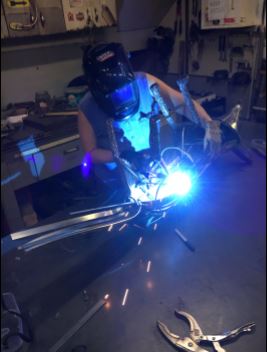
Music was a big influence on Martens’ childhood. Her parents bought her a used Gulbransen upright piano on payments when she was in first grade. Practicing everyday after school taught her patience because doing it over and over was the only way to get it right. But when she went on to major in piano in college, she quickly learned that playing piano well wasn’t necessarily the best career choice for her and she changed her major to interior design.
In her early twenties, Martens was involved in a start up bicycle business with her first husband, but rather than working in sales or doing the books, she became a mechanic. Over the 13 years there she became an expert wheel builder and built many custom racing wheels for Tour de France wannabe’s living in the area. After the birth of her son, Martens returned to college where she completed a Bachelor’s degree in communications but it was a final elective class that really steered her life in a new direction. The class was Desktop Publishing and the skills Martens learned working on that first tiny Macintosh computer screen would affect her work direction for the next 30 years.
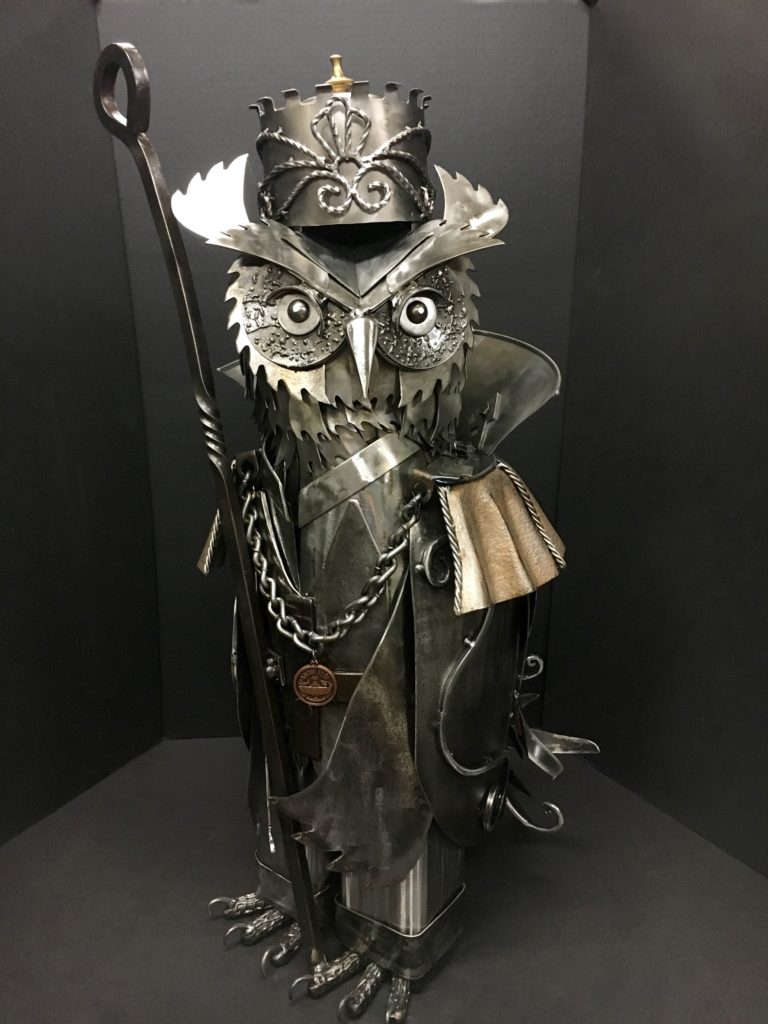
After college she worked at a newspaper for a few years as a desktop designer putting together local grocery flyers, seed corn ads, auction bills and the like. It was a fun and creative time and Martens enjoyed computer design and maintaining the bank of computers that churned out the daily ads. In 1997, Martens again made a career right turn when she accepted a position as the head of advertising for a large Berkshire Hathaway company located in Omaha, NE. This position, although monetarily rewarding, was lacking the hands on creative work that was Martens’ lifeblood and she soon found herself restlessly casting about for creative outlets. She loved gardening, reading, camping and traveling. She knew she was not a talented artist in the general sense but she knew there had to be some other creative outlet that would let her use her artistic abilities in new ways.
In 2009 a new marriage and a move to a quiet country setting provided the exact set of circumstances for what would come next. Her new husband was a car guy and possessed welders and torches, drill presses
and vice grips and all the other tools necessary for building and restoring cars. When he decided to take a welding class at the local community college to learn to weld better, he signed his wife up too. She was less than enthusiastic about the class, and even though she was the only girl in the class and despite it being an industrial welding class, she was a standout pupil. She had found her medium.
And here’s where that farm that she spent so much time at as a child comes in. That was the first place Martens dug around for scrap metal for her projects. She carted home used planter discs, old wagon wheels, hog waterers and chicken coop castoffs. She walked ditches searching for abandoned farm equipment and then loaded it on a trailer and hauled it home. At first she gave everything she made away; decorative flowers, funny owls, big birds. Then requests started. “I need a trellis for my grapevines; Can you make me something for my fireplace? It’s our anniversary and I wonder if you could design something for my wife?”
In 2013 Martens did her first large exhibition, a RAW event in Omaha. Over the years she did other shows and exhibits but most of her sculpture sales resulted from gallery representation and posts on social media. She does commissions but likes to focus on all the projects in her head where the flow of ideas never stop.
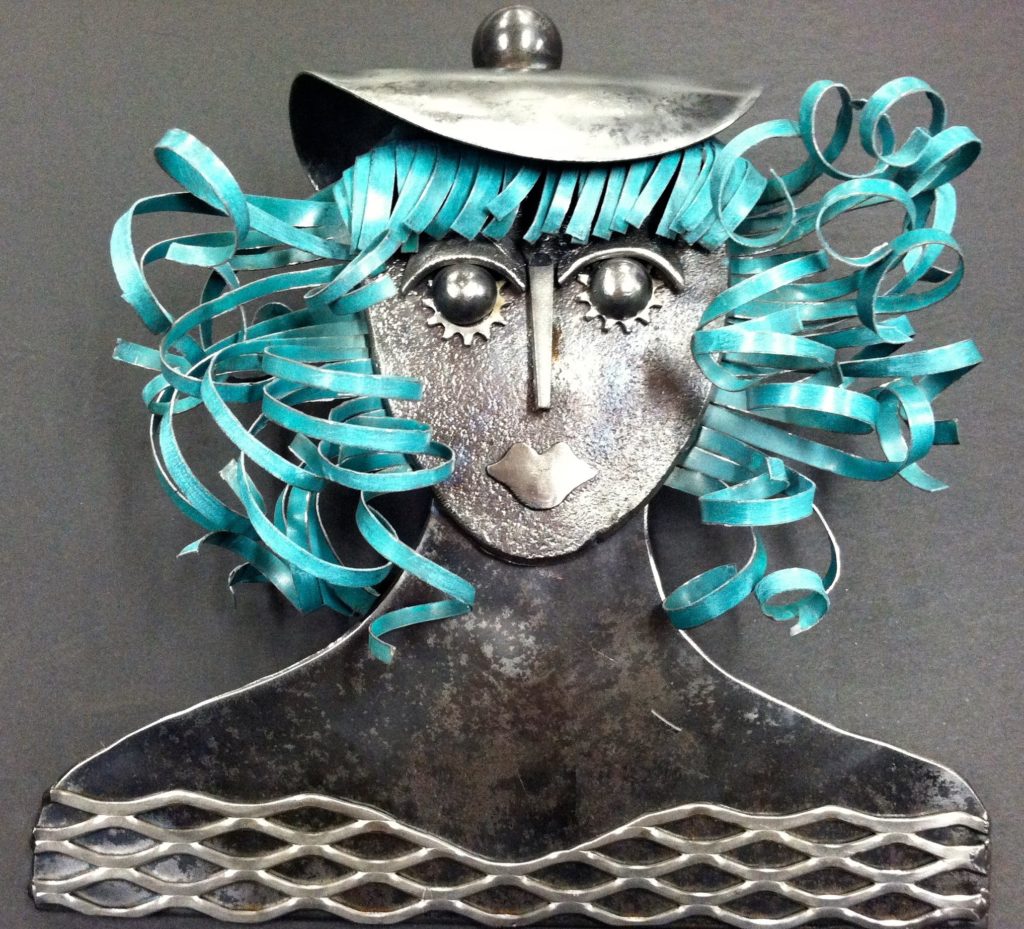
Martens works exclusively in steel, either new or scrap and some sculptures are a combination of welded and assemblage pieces. She enjoys animal themes — owls, foxes, birds, fish, horses, cats and even a penguin, but she has also created many outdoor pieces — trellises, birdbaths, arbors and suns. Early on Martens became fascinated with how easily certain types of metal could be made to resemble fabric. She did a series of female busts after she discovered a piece of scrap shaped like a head in some steel cutoffs she received from a friend. That became her first bust titled, “Bridgette,” aptly named because of her sweet beret and blue hair. Other early themes include kitschy animals and crazy monsters, including, “Mickey Grilly,” a Pacman like entity made from a junk Weber grill.
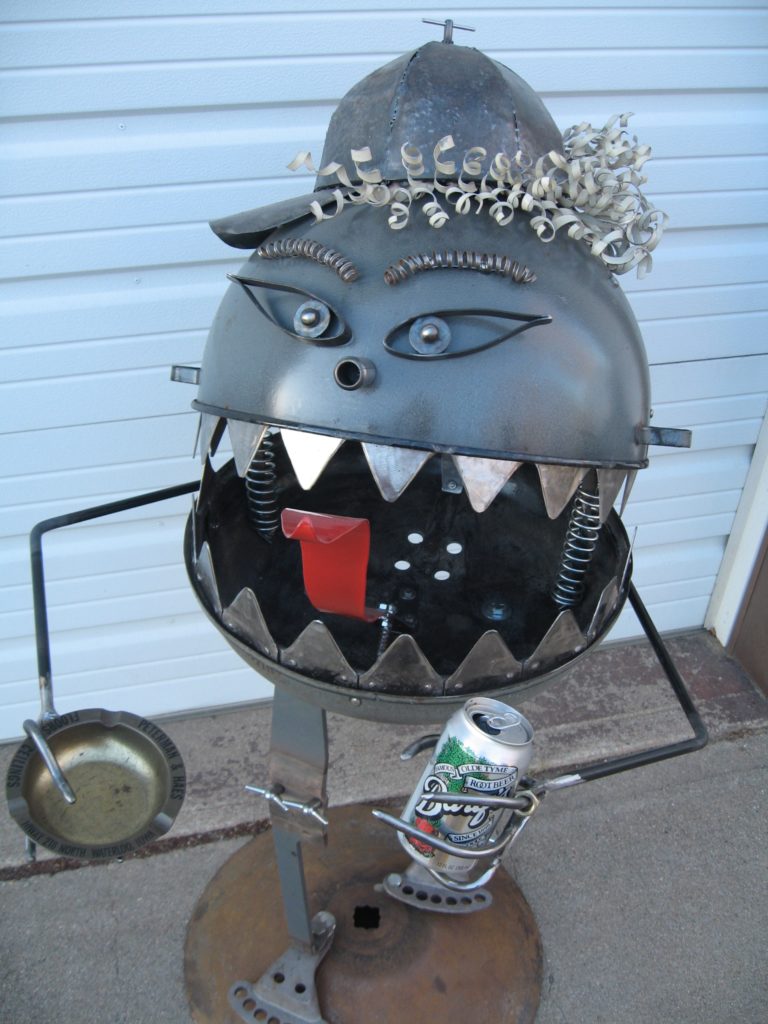
She has refined her methods and processes for the past 10 years moving from two dimensional work into almost exclusively three dimensional pieces. When Martens is working on an animal sculpture she references photos of that particular species and looks for scrap that can represent the type of movement the animal is doing. Many of her pieces make use of circular saw blades because they make wonderful feathers, fins and fur. She has even used saw blade pieces as flounces on a series of dresses she has created. “This type of art is different from most other mediums because I can’t just go to the art supply store when I am out of supplies,” she said. “I spend a lot of time searching for cast offs and scrap metal, whether it’s at flea markets, garage sales, thrift stores or back on the farm, I never know what I’ll need so I take home almost everything I find that I can haul and that I can afford.” She describes her art as mostly problem solving. “I find a piece that I think will work for an owl’s wing, for example, but it may need to be heated and bent or drilled and attached with screws or it may be made of difficult to weld material like cast iron which requires alternate methods of attachment.” So there’s always a problem she must solve before she can make something work. Another consideration for someone doing this type of art is that the machines used are expensive and they require regular maintenance. Luckily for Martens, her husband is handy and helps with welder,

There is always a problem she must solve before she can make something work.
torch, plasma cutter, sand blaster and air compressor maintenance. Just switching from one diameter welding wire to another requires a complicated process of relooping the wire through the welder then testing to make sure the correct pressure is applied to the wire as it exits the stinger. And the procurement of the welding gas is also an expensive and dangerous necessity. The large gas tanks are refillable but must be loaded into the back of a truck with a hoist and securely tied down to avoid accidents or explosions!
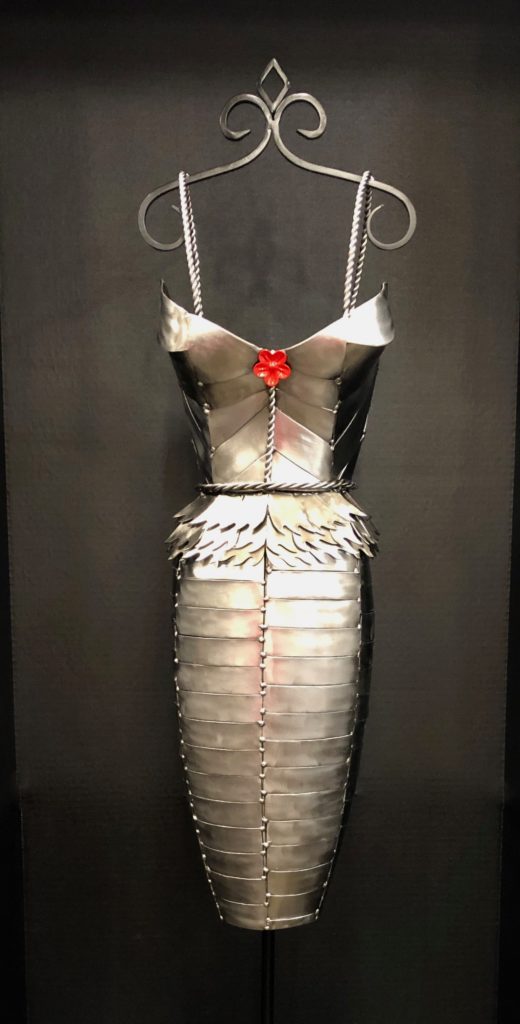
Martens was influenced by the works of many metal sculptures from the early 20th century. Alexander Calder’s mobiles and large works continue to fascinate her as does the work of David Smith, Lynn Chadwick, Louise Bourgeois and Abbott Pattison. A close friend, metal artist and blacksmith, Charles A. Wilkins invited Martens and her husband to Georgia one summer to see Pattison’s Iron Horse, where it sat in a farm field in north Georgia. It was removed from the University of Georgia amid controversy in 1954 and the history of the disgruntled student protests and subsequent vandalism of the sculpture and its secret removal from the University has been a source of fascination for decades and Martens was thrilled to be able to see it in person. Contemporary influences include the whimsical car part assemblages of James Corbett and Jud Turner and the kinetic, found-object sculptures of Nemo Gould.
Martens’ mission in life, as well as in her art is simple: Be kind, be useful, be productive.
Martens’ mission in life as well as in her art is simple: Be kind, be useful, be productive. She feels that people have so much to give and so many just can’t get motivated to get off the sofa. She hopes that through her classes she is able to give others that sense of accomplishment and capability that seems to be missing in today’s digital society. As she approaches becoming a full-time artist, she hopes to also continue her volunteer work with the elderly, spending time with her seven grandchildren, teaching and working to create art that uplifts, surprises and is loved for the way it makes her collectors feel.
